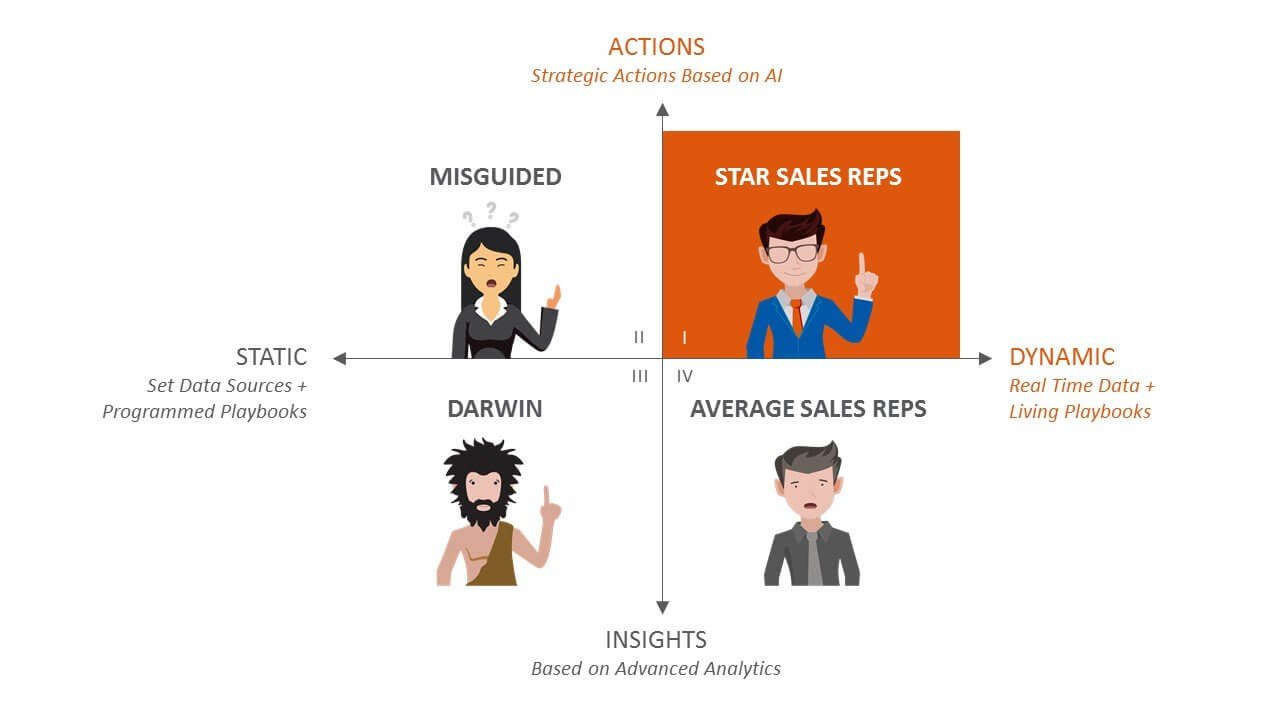38% of sales people say getting a response from prospects is getting more difficult (State of Inbound Report). AI is reversing this sales challenge, but only when you have these key criteria
In an earlier Absolutdata post, we talked about how AI is turning average performing sales reps (ASRs) in to star sales reps (SSRs). In this post, we’ll discuss what’s needed to move a sales organization toward excellence. To achieve superior performance across your whole sales organization you need two critical components dynamic data and strategic actions based on artificial intelligence. This powerful duo illustrates how AI is enabling sales forces to develop deeper, more successful relationships with their prospects, pulling deals over the finish line with greater frequency.
The Two Essential Criteria
- STRATEGIC ACTIONS, not just insights
Advanced analytics are making CRM and sales automation systems smarter, giving sales people better insights about prospects. But insights, even based on advanced techniques, are not good enough. Strategic Actions based on AI are getting revenue results. The power of AI takes the information beyond insights to give individual sales professionals guidance on specific actions they should take with specific prospects, and when they should make their move.
(deep dive post on insights vs strategic actions) - DYNAMIC MODEL versus static
Whether it’s static data from your CRM or even sophisticated pre-programmed playbooks based on advanced analytics (which are still pre-conceived static playbooks), the more static your data, the less advantageous to your sales force. To outperform, you need to make the transition to a Dynamic Model. From first contact to signing the contract, a buying cycle rarely takes a predictable path. Decision criteria change, key stakeholders shift around, competitive dynamics come into play. Near real-time data is the ultimate in helping drive AI-enabled systems to change the course of sales guidance as the terrain shifts.
(deep dive post on dynamic vs static data and playbooks)
Where You Want to Be
Mapping these two criteria on a scale illustrates the competitive advantage a sales organization can gain when AI is done right.
What kind of tools are empowering your B2B sales force, and where does that place your sales team in the above map? Here’s a brief explanation of how your sales teams can expect to compete with the technology you are providing:
Quadrant 1: Superstar Sales Rep or SSRs (upper right)
This supercharged sales team is armed with near real-time data that feeds an AI engine that constantly learns from what works and what doesn’t while taking the changing competitive landscape into account. This is machine learning in action, and it provides guidance on specific actions to take, prompting reps when to act. That gives this sales team the clear edge, and it’s translating to revenue.
Quadrant 2: Misguided (upper left)
Here, more sophisticated analytics even AI give reps guidance on specific actions to take instead of just providing insights. But these actions are based on static data in a changing landscape. Who’s to say these actions are pointing reps in the right direction? Although better than ASRs and Darwins, these reps will lose to the better-equipped SSRs.
Quadrant 3: Darwin (lower left)
Here, only the sales people with the strongest natural sales instincts win. Only the basic tools are provided CRM data and some insights based on data. Reps are then left on their own to find their way to a deal. This is the status quo in many companies today, where you can expect 80% of sales to come from 20% of your sales reps. This leaves most of your sales force with less chance to compete in a sales situation and missing quotas on a regular basis.
Quadrant 4: Average Sales Rep or ASRs (lower right)
This sales team has the sophisticated edge of real-time data, but they don’t get specific action guidance, only insights. So, reps are left to interpret insights and make their own action plans on how to best drive an opportunity forward. They’ll rely on their established personal approach, and you again get the status quo 80/20 rule, where 80% of the sales still come from 20% of your top performers.
Checklist For Choosing The Right AI Solution
So, how do you evaluate all the solutions out there, and what should your criteria be for choosing the most powerful AI solution for your sales teams? Here’s the checklist:
- Uses near real-time data: Your system should be capable of ingesting and harmonizing data from various sources daily or at least weekly.
- Provides guidance that reflects changing data: Avoid pre-programmed playbooks. Even playbooks based on more advanced techniques like predictive analytics are static; ensure your guidance is updated as new data becomes available. At Absolutdata, we call these “living playbooks.”
- Incorporates machine learning: Make sure the engine is capable of machine learning, also called deep learning. This capability changes what direction is given based on the current landscape, and gets smarter over time.
- Spells out customized steps: Look for solutions that give sales reps a customized set of actions they can take over the short term (1-5 working days) and one that explains why the actions are being recommended.
- Easy to use and flexible: Make sure sales reps find the solution easy to use, with the flexibility to adjust or even decline the guidance. This helps the system get smarter over time.
To break the 80/20 logjam and turn everyone on your sales force into a Star Sales Rep, you need access to dynamic data that generates strategic guidance and actions, not just insights. With dynamic data and strategic actions, your team can deepen prospect relationships and deliver a higher win rate consistently.
Related Absolutdata products and services: NAVIK SalesAI, NAVIK AI Platform, AI & Data Science Services, Data Integration Services, Tech
































